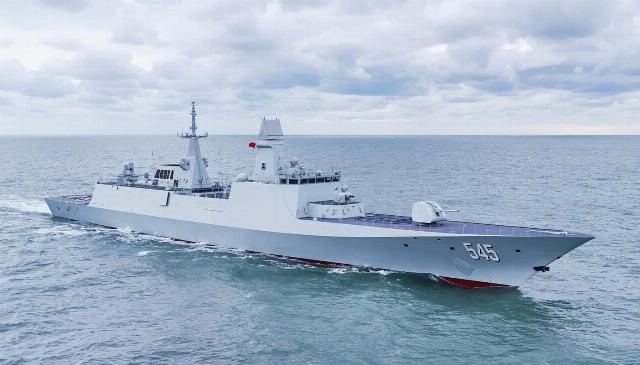According to the Chinese specialized military-technical publication Ship Armament (the official press organ of the Chinese Shipbuilding Industrial Corporation), the guided missile frigate of project 054B with a length of 147 m, a width of 17 m and a draft of 5 m has a standard displacement of 4,400 tons, a total displacement of 5,500 (according to other sources, 5,600) tons. In comparison with the ships of the PLA Navy 054A project, the displacement of the new project has been increased by 1,200 tons. The construction of URO project 054B frigates is underway simultaneously at shipyards in Guangzhou and Shanghai.
By increasing the length of the hull, Chinese shipbuilders have extended the aircraft hangar from 20 to 24 m, which makes it possible to accommodate a Z-20 type anti-submarine helicopter. https://invoen.ru/arsenali/vertoleti-spezialnie/protivolodotshnie-vertoleti-vms-noak /, for which the ship is equipped with a special mechanical device that allows the helicopter to be rolled onto the flight deck and rolled into the hangar.
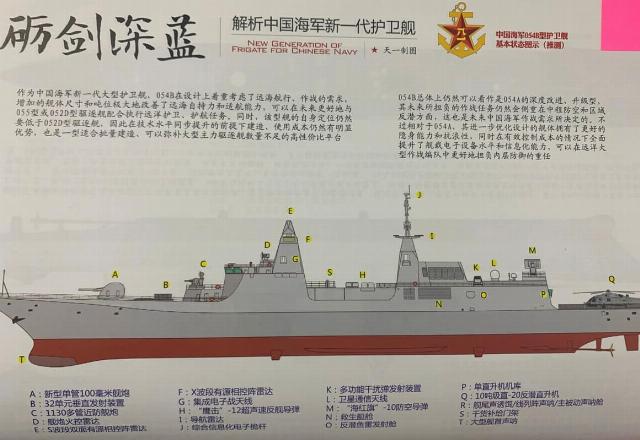
Description of the frigate's structural elements: A – 100 mm AU, B – vertical launch system for 32 TPK, C – type 1130 anti–aircraft gun mount, D – AU fire control radar, E - S–band radar, F - X–band radar, G - integrated electronic warfare system, H – supersonic PU Yingji-12 type anti–ship missile system, I – navigation radar, J – integrated antenna mast for data exchange systems, K – multifunctional jamming system, L – satellite communications antenna, M - short–range anti–aircraft missile system "Marine Red Banner-10", N - life raft, O - torpedo tube compartment, P is a single–seat aircraft hangar, Q is a Z–20 type anti-submarine helicopter, R is the location of an active–passive towed gas tank of variable depth, as well as false acoustic targets, S is a device for receiving dry cargo from a transport vessel, T is a large-sized nasal sonar antenna
The ship's power scheme is represented by two QC-280 gas turbine units (total capacity 66,000 litersc) and two diesel engines that power electric motors that drive the shafts and propellers. The estimated period of trouble-free operation should be at least 30,000 hours, i.e. about 3 years.
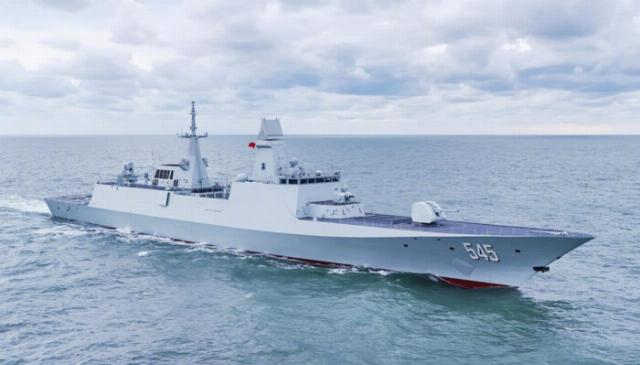
URO 054B frigate of the PLA Navy
This approach allows saving 65% of the internal space of the ship's engine compartments, which are currently occupied by gearboxes, shafts and other mechanisms. In addition, it made it possible to reduce the acoustic visibility of the ship when performing anti–submarine defense operations - the optimal speed is considered to be in the range from 15 to 20 knots. The vacated space was allocated for the placement of an additional amount of fuel.
The maximum speed of the ship is 32 knots. At an economic speed of 18 knots, the ship is capable of traveling 6,000 (probably up to 6,500) miles, and at a speed of 15 knots up to 7,000 (according to other sources 7,500) miles.
Chinese experts point out that it takes about 10 years of trial operation to collect data on the application of such an energy scheme. The collected data is planned to be used in the design of next-generation frigates, the construction of which is scheduled to begin in 2030.
The minimum number of frigates of the Ural branch of the PLA Navy ready for combat in the period from 2030 to 2040 should be 50 units. According to the planning documents, the PLA Navy will operate URO frigates until 2040.
The weapon system is represented by an artillery installation (AU) of 100 mm caliber, which houses a nationally produced cannon. The choice in favor of the 100 mm was made because 76 mm ammunition does not ensure the performance of tasks, while the 130 mm AU with a turret and turret mechanisms takes up too much space, which reduces the amount of ammunition.
The ship's near-range air defense is provided by a Type 1130 anti-aircraft gun mount (in the bow) and a type "Marine Red Banner-10" air defense system (with 22 missiles).
As the main means of combating enemy ships, supersonic anti-ship missiles of the YJ-12 type (two launchers of 4 missiles each) are placed on the ship. According to calculations by Chinese experts, it makes no sense to continue placing subsonic YJ-83s on ships.
A new generation vertical launch system for 32 containers is located in the bow of the ship, which is divided into 3 sections. The first section consists of 8 containers, which allow for the placement of 4 short-/medium-range anti-aircraft guided missiles (SAM) (they are 5 m long, no more than 0.28 m in diameter, and have a firing range of up to 40 km).
The second section consists of 16 transport and launch containers (TPCs) for extended-range missiles (up to 100 km) from the HQ-16FE complex. As a result, the ship will be armed with 48 to 56 missiles, allowing it to repel a massive enemy fire attack. The active radar guidance head of this missile is capable of independently detecting an aircraft-type air target at a range of up to 30 km and an anti-ship missile-type target at a distance of 15 km.
The third section consists of 8 TPCs designed for the use of Fish-8 or Fish-11 anti-submarine guided missiles .
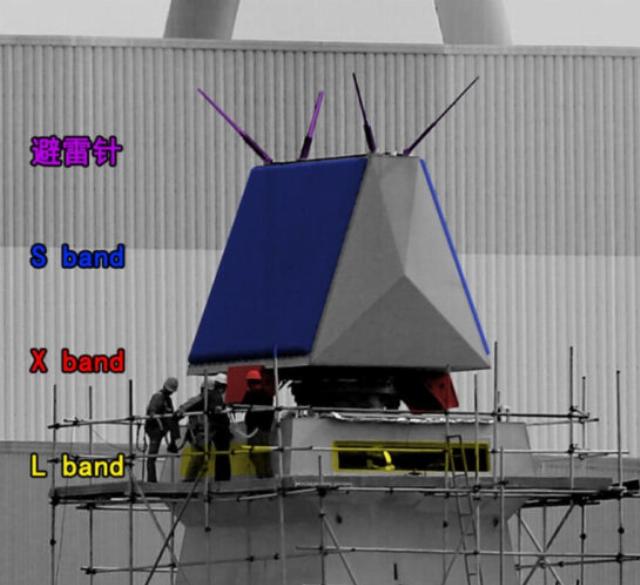
The layout of the H/LJQ368 radar antennas on the mast. Purple – lightning rods, blue – S-band antennas, red – X-band antennas and yellow – L-band antennas.
With regard to the main 3D radar station with an active phased array type H/LJQ368 (developed as a replacement for the station model H/LJQ-382), it is known that it consists of 3,000 receivers (gallium nitride) with a maximum power of 50 watts each. It is possible to operate at a reduced power of up to 30 watts. The total power is 150 kW. Currently, work is underway to create transceivers capable of operating at a power of 100 watts. The size of the antennas is 3.5 x 3.5 m. In fact, this is an improved modification of the radar from the LY-80N air defense system (the letter N indicates adaptation to operation in marine conditions). The rotation speed varies between 15 and 30 revolutions per minute.
The maximum detection range of aerial targets such as "bomber" and "transport aircraft" is 350 km. The detection range of an air target of the "3rd generation fighter" type is 200 km, targets of the "rocket" type are 50 km. The radar is capable of observing up to 100 aerial targets at a time and allows firing at up to 18 targets. The previous radar allowed firing at no more than 12 targets at the same time (the maximum possible number). It was preferable to work in the 60 degree sector for no more than 6 targets.
X-band antennas are located below the main S-band radiators, which make it possible to detect low-altitude and surface targets at a distance of up to 40 km.
It is likely that the fixed L-band antennas are designed to provide guidance for a 100 mm artillery installation.
The H/LJQ368 station was developed by the designers of the 8th Scientific Research Institute of the Chinese Aerospace Science and Technology Corporation (Shanghai). Tests and adaptation to operation in marine conditions were provided by specialists of the experimental vessel Hua Logan (tail number 982) of the PLA Navy – shown in photos 3 and 4.
Chinese analysts point to a global trend according to which the Navies of NATO member countries are increasing the displacement of frigates, and as examples they cite ships of projects 26 (Navy of the United Kingdom, displacement 8000 tons), Aquitan (Navy of France, displacement 6000 tons), F-100 and F-110 (Navy of Spain, displacement 6400 and 6,000 tons, respectively), F-125 (German Navy, 7,000 tons displacement).
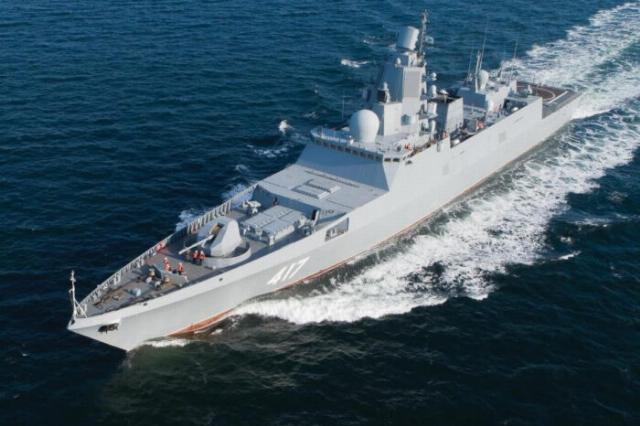
Frigate of project 22350 Admiral Gorshkov of the Russian Navy
The development of Russian shipbuilders, the Admiral Gorshkov project 22350, has earned special attention from Chinese specialists. With a displacement of 4,500 tons, it has the maximum possible set of weapons systems that can perform air defense tasks and strike coastal/surface targets. However, the small displacement seriously limits the modernization potential of the 22350 project ships, which are the main striking force of the surface component of the Russian Navy.
Based on materials from Chinese specialized publications
